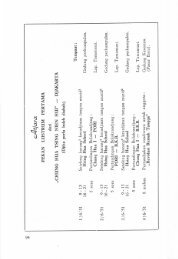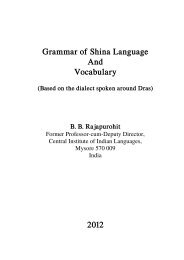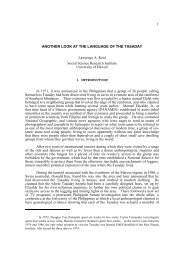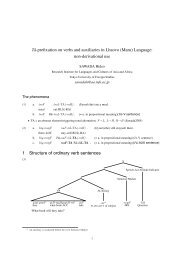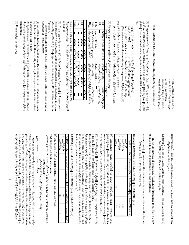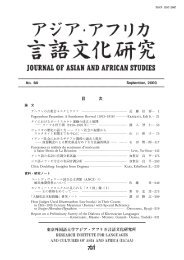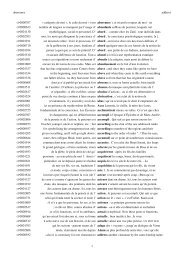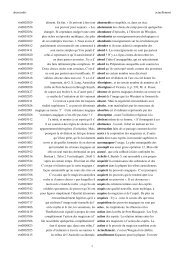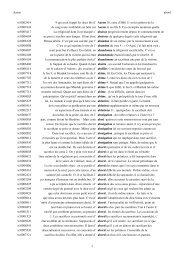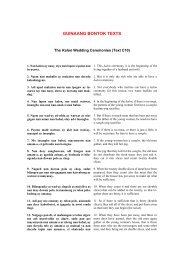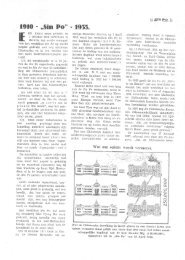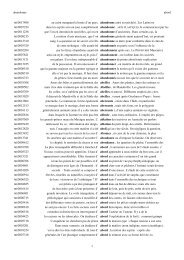Tonal Notation of Indic scripts in Mainland Southeast Asia
Tonal Notation of Indic scripts in Mainland Southeast Asia
Tonal Notation of Indic scripts in Mainland Southeast Asia
You also want an ePaper? Increase the reach of your titles
YUMPU automatically turns print PDFs into web optimized ePapers that Google loves.
(29) {-a} {-aa}<br />
/-a/ /-ai/ with {-k’}, {-ng’}<br />
/-O/ /-a/ with {-c’},{-N˜’},{-t’},{-n’},{-p’},{-m’},{-r’},{-l’},{-s’}<br />
— /-a/ with {-y’}, {-w’}<br />
/-a/ — with {-@’}, {-h’}<br />
(/-aP/) 19 /-a/ without any f<strong>in</strong>al consonant<br />
If Burmese <strong>of</strong> the time had determ<strong>in</strong>ed the usage <strong>of</strong> {-a} and {-aa}<br />
<strong>in</strong> reference to the phonogramic relation between Mon script and the<br />
sound <strong>of</strong> Mon language, it would lead us to an improbable consequence<br />
that such pairs as {taang’}/{tang’} ‘put’, {kaan’}/{kan’} ‘pond’ do not<br />
represent an identical syllable.<br />
To clear the problem, we must assume that the phonogramic relation<br />
<strong>of</strong> Mon script referred <strong>in</strong> determ<strong>in</strong><strong>in</strong>g the spell<strong>in</strong>gs for these OB<br />
sounds is not to Mon sounds, but to Pāli sounds, as far as Shorto’s reconstruction<br />
is correct. It does not necessarily mean that Burmese did<br />
not make reference to the phonogramic relation between Mon script<br />
and Mon sounds at all. It must have been referred <strong>in</strong> such cases as f<strong>in</strong>al<br />
glottal stop we saw <strong>in</strong> 2.4.1.<br />
Another potential problem is that the <strong>in</strong>terpretation might cause the<br />
<strong>in</strong>conformity between OB and Mod.B situations: <strong>in</strong> Mod.B, a syllable<br />
<strong>in</strong> Heavy tone is usually heard longer than the same syllable <strong>in</strong> Level<br />
tone. But it might not constitute a problem, because it is not always the<br />
case that the phonetic feature <strong>of</strong> a tone ma<strong>in</strong>ta<strong>in</strong>s throughout its history.<br />
2.6 Development <strong>of</strong> tone marks after 13c<br />
2.6.1 From ß`’<br />
{-@’} to ßä {-.}<br />
The spell<strong>in</strong>gs for /-a/, /-i/, /-u/ <strong>in</strong> Creaky tone were unified <strong>in</strong>to {-a},<br />
{-i}, {-u} by around 600 ME (AD 1238). The occurrence <strong>of</strong> {-@’} is<br />
limited to closed rhymes, with exception <strong>of</strong> ęa¸ {-e@’} ‘SENTENCE<br />
MARKER/ GENITIVE MARKER’.<br />
a {@} <strong>of</strong> Bagan period had the shape like H. When used as a subscript,<br />
its horizontal stroke tends to be omitted. The <strong>in</strong>stances <strong>of</strong> {@}<br />
without the horizontal stroke is already seen <strong>in</strong> the obverse <strong>of</strong> Ta<strong>in</strong>gchut<br />
Temple Inscription (541 ME/AD 1179), but it aga<strong>in</strong> is around 600 ME<br />
when the shape <strong>of</strong> {@} became popular.<br />
The balance <strong>of</strong> ‘Creaky-sensitive’ <strong>in</strong>scriptions and ‘non Creakysensitive’<br />
<strong>in</strong>scriptions began to be lost after 600 ME. Which marked<br />
a turn<strong>in</strong>g po<strong>in</strong>t is a series <strong>of</strong> Inscriptions <strong>of</strong> K<strong>in</strong>g Kyazwa’s Royal Order<br />
dated 611 ME (AD 1249), found at several places <strong>of</strong> Upper Burma.<br />
After that, ‘non Creaky-sensitive’ <strong>in</strong>scriptions became the ma<strong>in</strong>stream,<br />
24



